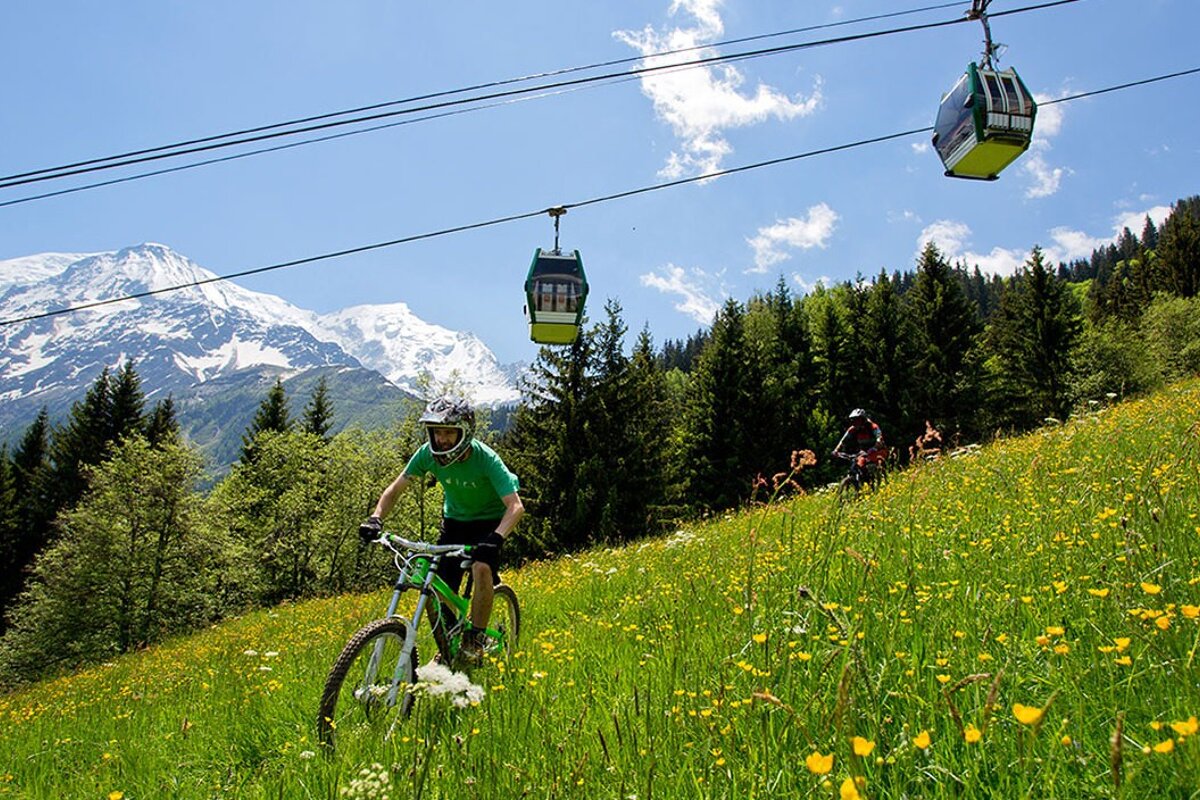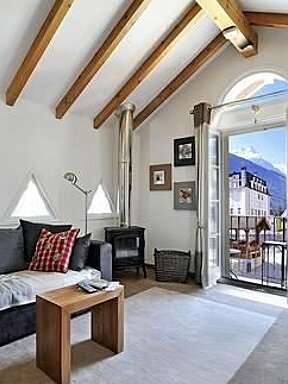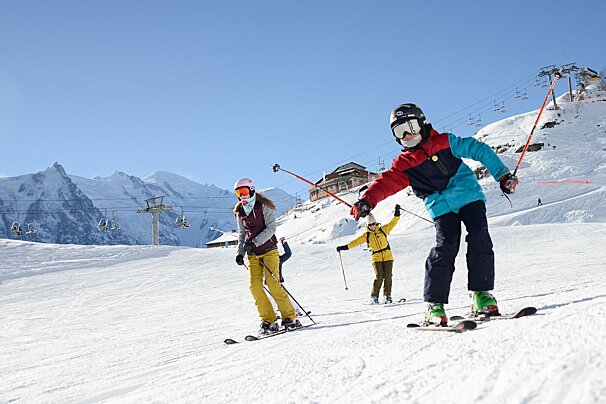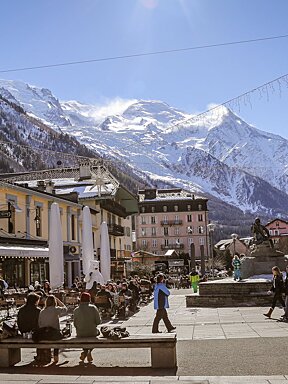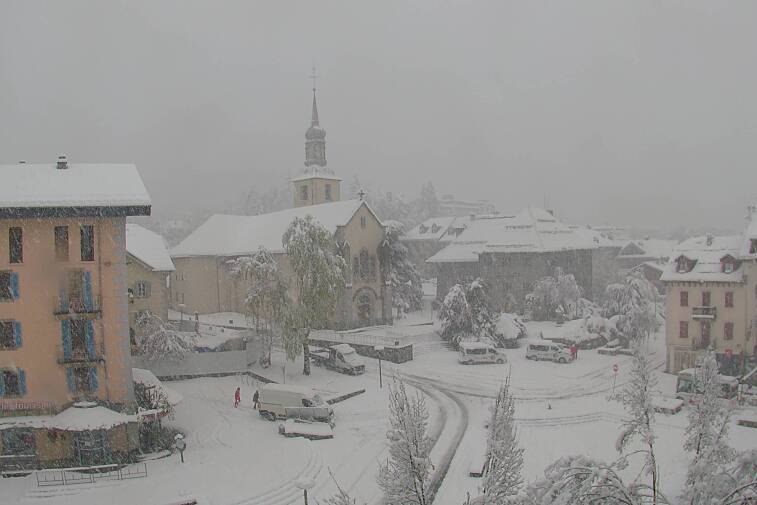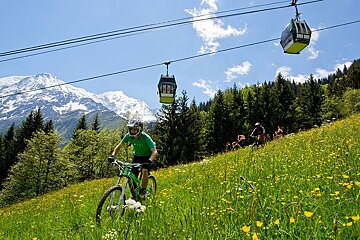
© Tom Humpage
Mountain Biking in Chamonix
Discover the top Chamonix mountain-biking
Chamonix has a real mixture of trails offering something for riders of every ability.
There are a number of relatively easy and picturesque trails which criss-cross around the Chamonix valley, some lung-busting technical ascents, lots of wooded and open single track, downhill specific tracks with north shore, and a fair bit of lift access for those not keen on pedalling uphill.
And if you don't have all the gear, you can rent it when you get here either through your accommodation provider or through local sports shops and mountain bike guides.
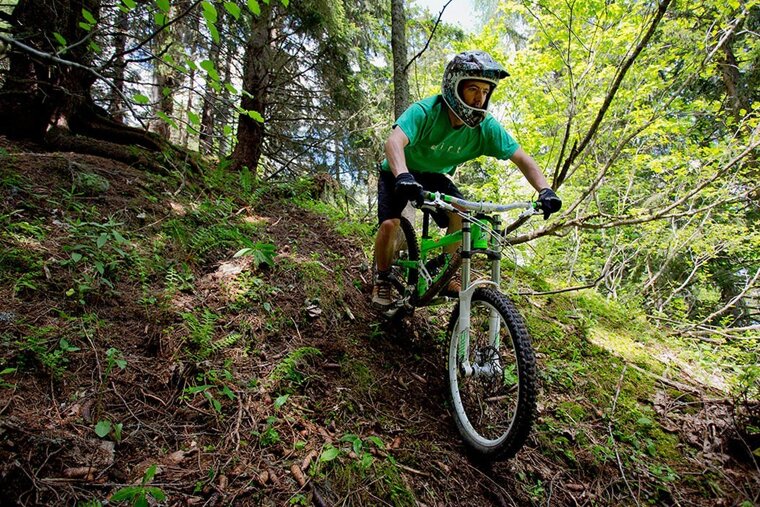
Biking routes
Mountain biking in Chamonix is still in development compared to a lot of other summer resorts.
The valley is 16km long and the biking areas are spread out and not as interconnected as you'd find in most other mountain bike resorts. Bike buses operate in peak season (July and August) and you can take your bike on some of the trains, but they don't run all day long.
July and August
You'll also have to take into account that as Chamonix is a big destination for hikers, there are many restrictions in place for mountain bikers, especially on singletracks, and in July and August you're not allowed on the main walking trails in the valley.
If you want to make the most of what's on offer (especially XC riders) we recommend you come to Chamonix a little either side of these dates. If you don't mind not having lift access at all, then the end of May, June, September and October are also good times to visit.
Links to other resorts
Chamonix’s geographical location allows some of the more experienced riders to interlink into neighbouring Switzerland and Italy. There’s a five day ‘Tour du Mont Blanc’ which takes riders on a 200km brutal uphill and brake smoking descent around the Mont Blanc whilst displaying some of the most stunningly beautiful scenery in the Alps.
If you are considering doing a 'twin resort' trip, Chamonix is also a perfect base to reach other fabulous mountain biking areas such as Verbier, Megeve, Les Contamines, Courmayeur, Pila, La Clusaz and the famous playground of Morzine and Les Gets. All of which are only about an hour's drive away.
Chamonix
Chamonix is definitely a technically challenging area, with many obstacles and serious rooty and rocky natural trails that require intense concentration and skill from the rider. Some trails are definitely not for the faint-hearted.
If you're looking for an easy level of riding, there are plenty of low level cross-country trails along the river l’Arve which passes through the small villages that make up the ‘Chamonix valley’ including Les Gaillands, Le Praz, Argentière, Le Tour and Les Tines.
The Petit Balcons Nord and Petit Balcons Sud offer a little bit more technical riding, with a fair bit of rooty and rocky sections, and take you to a higher elevation from the valley floor. There are a number of different routes leading to and from these that you can easily follow on a map, or with the multitude of signs and way markers along the trails.
Lift access for mountain bikes
For those looking for a bit more downhill action, you can get lift access in some of the télécabines (cable cars) operating at the five main areas namely: Les Houches, Le Brévent, Flégère, Le Tour and Les Grands Montets. (Please note you cannot take your bikes on the Aiguille du Midi lift or L'Index chair at Flégère).
The lifts are open from mid June until mid September and have specifically adapted racks for your bikes allowing you spend more of your time riding incredible alpine terrain rather dragging yourself up steep inclines. Most of the lifts within the valley permit bikes to be taken on board free of charge, the only exception being the Aiguille du Midi where bikes are forbidden.
Lift passes can be bought at the lift stations on an individual ascent basis. However if you're here for a few days and are going up and down many times during your stay, it's more economical to purchase a Mont Blanc Multipass which gives you unlimited access to the main cable-cars in the valley either for a number of consecutive days (cheaper), or for a number of non-consecutive days. Non-consecutive passes must be used within a seven day period though. Les Houches operates as an independent ski area from the rest of the Chamonix valley. Daily passes are possible and for more information consult the Les Houches tourist office.
By using the lift system you can increase the number of great trails for riders of all levels in the valley.

Hiring and buying bikes
Whether to go full-suspension or hardtail is a question which creates a lot of healthy debate amongst the mountain biking community. Whether you're renting or buying you should first decide which type you're looking for, and there are numerous makes and models of both types available.
What bike to use
Full-suspension
Both front and rear suspension that is effective at absorbing lumps, bumps and jumps, thus providing better performance and a smoother ride.
Pros:
- much more comfortable and arguably more control over the rough stuff with more options to adjust to suit the terrain
- you can make a full suspension bike ‘lock out’ when needed, so the experience is like riding a hard tail
- can handle larger drops and jumps
- more forgiving and confidence-inspiring as they have a wider margin for error allowing you to ride above your skill level
- better tech beneath you - modern full-suspension frames are incredibly sophisticated
Cons:
- it can be more energy intensive on the uphill unless you have a ‘lock out’ facility on the rear suspension to avoid ‘suspension bobbing' as you climb
- a weight penalty for all that bump proofing suspension
- potentially more moving parts to repair should anything go wrong
- difference in price is quite significant
Hardtail
A bike with no rear suspension. Suspension forks may be at the front of the bike but its back post is rigid.
Pros:
- in general, tend to require less maintenance and perform better on steep uphill climbs and sprints to the finish line
- inexperienced or beginner riders may prefer to start with a hardtail complete with front, lockable suspension
- good to get a feel for preferred type of riding before progressing to a full-suspension bike
- on the whole more efficient as they're lighter, maintain speed and no energy is wasted compressing a rear shock as you pedal
- cheaper
Cons:
- because of the rigid frame you won't be able to make any adjustments
- less efficient on rough terrain, rather than rolling over, the rear tyre hops up off rocks and trees when on a rough trail
- less comfortable as those shocks and vibrations transfer through the bike into your body, using your arms and legs as shock absorbers which can be tiring
- less traction due to the rear wheel rebound on rough terrain
To rent or to buy
Renting
If you plan on renting equipment then there are plenty of Chamonix mountain bike hire shops hiring out both full-suspension and hardtail mountain bikes. On average you can pay anywhere between €16 to €80 for a day's hire, depending on whether you select a bike with or without suspension. It's also possible to hire mountain bikes for children from around €15 a day.
Buying
There are numerous makes and models of both types available to the potential buyer so when deciding on which type of bike is best, it's important to consider the following:
- your budget of course
- the type of riding you and your bike will be undertaking
- the typical terrain and angle of decent you will be riding
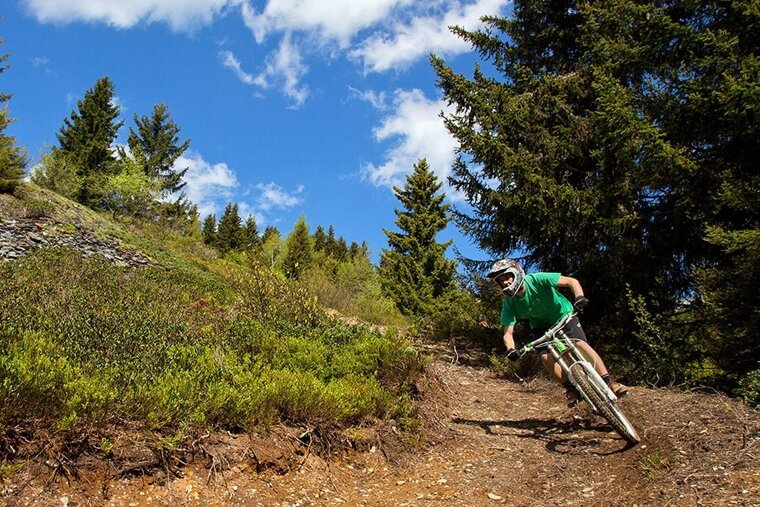
Equipment for cycling
When out and about on the trails, here's a checklist of what you will need:
- water - one of the biggest problems in this region is the heat. Fit two bottle cages to your bike and take 750ml bottles containing electrolyte drinks
- sunscreen - don't forget that summer in the Alps is very hot, the thin air and hot summer sun means you will burn quicker here than at home
- windbreaker - although it may be warm in the valley temperatures can drop rapidly as you climb, weather can change quickly and the rapid descents can cool you down fast
- snacks - energy bars and gels are a very good idea if you're planning a day out
- mobile phone - being able to contact someone to pick you up if your chain breaks is helpful
- money - you may need it in an emergency or just for a beer at the end of the day
- basic repair kit - you can't fix everything by the side of the road but not all breakdowns require the day to end
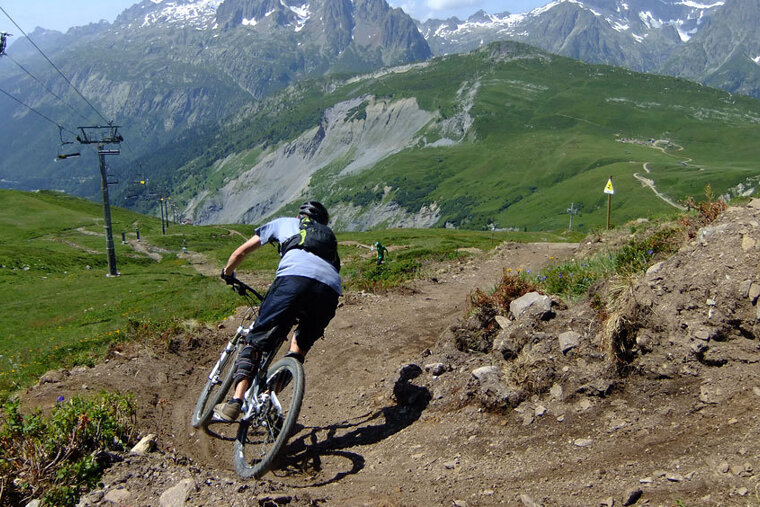
Cycling hotels and camps
There are numerous companies taking the hassle out of organising it all, offering tailor made mountain biking holidays. There are many specialist chalet companies that run catered holidays and several local tour operators offering active mountain biking programmes, with little extras here and there that perfectly suit a range of riding levels from beginners up to skilled riders.
They will guide you around the various biking trails, offering some great cross-country riding and single track trails with spectacular scenery in the background.
Due to the technical nature of the routes selected, they do tend to have small group sizes allowing for better riding experiences and usually do not take beginner riders on their guided rides. If not everyone's a biker, some offer a discounted rate for accompanying guests who are not riding.
Wherever you choose to ride, you will inevitably have a thoroughly enjoyable experience in and around the Chamonix area. The mountains are there to be enjoyed by everyone, so remember to be considerate of others when on your bike, following the 'mountain bikers code of conduct' at all times.

Flying with your bike
A review of the main airlines' Terms and Conditions, in relation to sports equipment baggage, indicates that it's highly likely that you will be subject to a charge for taking your bike on board.
Easyjet, Aer Lingus, Ryanair, and KLM all charge an additional one-way fee to carry your bike. At time of writing British Airways (and their partner Swiss Air) does not charge extra fees for taking bikes on their planes, providing they fit within the free baggage allowance and are packed in a hard shelled container, but we recommend you always check when booking.
Make sure that the combined weight of your luggage does not exceed your allowance. Although you may have paid an excess for your bike, its weight may be added to the weight of your hold luggage and there can be a penalty for any kg over the allowance.
How to bring your own bike
Before you travel
We'd advise your bike is in tip top condition before lugging it all the way over to France. A day riding in the Alps equates to many rides in the UK, and the wear and tear on your bike reflects this. If you start the week with your bike in a poor to average state of repair it will let you down at some point and spoil the day, if not the week's enjoyment.
If you're not a competent bike mechanic then have your local bike shop service your pride and joy. It's also money well spent to upgrade your tyres if they are of the lighter weight cross-country variety, and purchase some free ride tyres with a 2.3 section to smooth your way and avoid the punctures.
There is every chance a set of brake pads will disappear in a week, so bring a spare pair and carry them with you on the trails to avoid that metal on metal effect!
If you run out of time before you come away, Chamonix local bike shops will be able to carry out a service for you.

Packing your bike for a flight
Check the rules of transporting your bike with the airline you're travelling with and make sure you have reserved your bike's spot on the plane.
Most airlines stipulate the following:
- bikes should be contained within a protective box or appropriate bike bag
- only one bike should be carried per box/bag, and no other items (except protective padding) should be included within the box or bag
- handlebars and pedals must be fixed sideways against the frame or removed
- tyres should be deflated slightly to reduce the risk of damage
Bike travel insurance
Check out your travel insurance arrangements to ensure your bike is covered.
Bike packing options
- cardboard bike box - pick up for free from many cycle shops. These boxes are ideal to travel with, you can recycle it on arrival and get a new one before you return home. These can be a nightmare to move around where there aren't any luggage trolleys available.
- CTC bike bag - heavy-duty polyethene bag designed for bikes, you'll need to deflate the tyres, remove the pedals and turn the handlebars inwards, but likely you won't have to remove the wheels. Not all airlines will accept these bags, due to their lack of protection, so check before you buy one.
- dedicated bike bag - either hard or soft case, the former providing more protection against damage, they have padding in all the right places and some have wheels for ease of travel.
Top tips:
- put all your clothes in plastic bags and use them to pad the bike
- in addition to bubble wrap (and clothing), purchase some pipe lagging and zip ties from a DIY store to put around the frame of the bike for protection during transportation
- the most frequently damaged part of a bike is the rear gear hanger, so remove the rear gear mechanism and tie wrap loosely to the frame to avoid this.
- this applies almost equally to disc brake rotors if your bike sports them, so take them off, likewise pedals, it's only a five minute job and will prevent you engaging in a fruitless search for an obscure part in resort
- print out the airline's policy on carrying bikes and have it ready to politely show at check-in if necessary.
- if you've booked your bike on the flight, print your booking confirmation and carry with you when you travel
- leave yourself extra time at the airport to allow for any check in issues

Taking your bike on the train
Going on holiday to France with your bike is pretty straight forward, but as with a lot of things, it's better to book in advance.
The Eurostar
Currently only allows you to take your bike on selected trains between London and Paris, so it's best to book early to avoid disappointment. At the time of writing, Eurostar was working on reopening the service to other destinations in the near future, so check available routes before you start planning. Follow the steps on their website for reserving a spot for you and your bike.
Once you're in France getting around with your bike can be straight forward, but again planning ahead and getting to the station early are highly recommended.
Domestic or regional trains (TER) and tourist trains
Quite often they allow you to transport your bike for free, although you may have to put it in a bike compartment, hang it from a hook to save space, or fold it up and take it on as hand luggage. Spaces are limited and you cannot reserve in advance, and in some regions bikes aren't permitted Monday-Friday during rush hour.
TGV InOui
You must book a space for your bike if it's non-folding and this needs to be done when you buy your ticket. Your seat will automatically be placed near to the bike rack.
Regional trains
In Ile-de-France, (the region surrounding Paris), these trains are called Transilien and they are the country’s busiest commuter trains. They operate into all of Paris’ stations and run on lines with a letter associated (line K, line P, etc). They also include the RER trains, which run on lines A to E. You can take your bike on board a Transilien Monday to Friday, before 06:30, between 09:30 and 16:30, then after 19:30; at any time on weekends and public holidays and at any time if it's folded or placed in a bike bag and does not cause fellow passengers any inconvenience.
Intercity trains
It's best if you can dismantle your bike and carry it on in a bag no more than 130x90cm. Some of these trains require a seat reservation, whereas others do not. Consequently, according to the type of train, it may or may not be necessary to book, or pay, for a place for your bike.

E-mountain biking
This is an industry that has seen incredible interest and growth, largely due to rising technological advances and rapidly charging batteries, and it being an eco-friendlier and cheaper alternative to mainstream transportation.
Specialized, one of the big three, was one of the first to introduce e-bikes to their mountain bike line-up, and now almost every bike brand has several eMTBs on offer.
What is an eMTB?
A mountain bike with an integrated motor that assists the rider when pedalling.
There isn't a throttle, so if you don't pedal there is no support, and they only provide support up to a certain speed limit: the speed limit in Europe is 25km/h and 32km/h in North America.
Whether they are hardtail or full-suspension, there are three distinct categories: Light, All-round, and Power.
They come with all the things a traditional mountain bike has, but they are heavier and have distinguishing features such as an electric motor, a battery pack, and a handlebar-mounted computer that controls it all.
The assist modes consist of: off, low (barely helps), medium, eco, and a battery-draining sport/high mode.
What to consider when buying an eMTB:
- full-suspension or hardtail? According to the experts there is no good reason to ride a hardtail, unless you only ride on well-maintained roads or in the city. The more affordable price and lower maintenance costs are the main reasons you may buy hardtail.
- how much travel? This refers to the suspension and is a measurement of how much a wheel can move to absorb bumps. As a rough guide 130-170mm is ideal for all-round use. Bikes with less are usually trekking bikes, and more is suited to extremely demanding terrain.
- cost? Very manufacturer dependent, but a full-suspension eMTB will set you back at least €4,500 to €5,000, but the sky's the limit. Hardtails usually come in around €1,000 cheaper.
- what is the range? Heavily dependent on battery capacity, the mode selected, rider weight, and elevation profile.
Key terms:
- battery capacity - indicated in watt-hours (Wh). Depending on the bike this varies from 250Wh-1,000Wh.
- motor output - specified in watts.
- torque - measured in newton metres (Nm) and describes the driving force with which the motor supports the rider when pedaling. The higher the torque, the more assistance.
- wheel size - 27.5", 29" or a mix of the two are the three common wheel size combinations.
- suspension - depending on the purpose and model this varies between 100-200mm.
Fat tyre eMTBs
You'll see these around the trails from time to time, and simply put they are an eBike with tyres of four inches plus in width.
Designed primarily to ride over snow, the heavy-duty tyres gives a greater ability to travel over more surfaces than bikes with a normal tyre width, such as snow, dirt, sand, wet stone, loose ground like leaves, twigs and rocks, and pavements or parks.
They improve balance and stability on any type of terrain, and are therefore perfect for those who want more versatility and comfort, as comfort is definitely their greatest advantage. Rising in popularity, they can be harder to handle on the trails as their braking isn't as precise and performance isn't as good as with a bike on regular mountain bike tyres.
Also worth remembering is that by having fat tyres, the frame, rim and axles are bigger and heavier, which isn't ideal for everyone.
Sharing the same trails
There has been some controversy in some areas around eBikes sharing the same trails as mountain bikers, hikers, horse riders etc., and in some countries and states they are banned from non-motorised mountain bike trails. Chamonix has trails open for eMTBs, with the possibility of getting back up using the lifts it just remains for you to go have some fun.
The majority of rental shops in resort will have e-bikes available for hire should you wish to try this fast-emerging sport for yourself... just be warned, it's addictive.
More inspiration...
For information on individual itineraries and bike parks, see our mountain biking routes.
